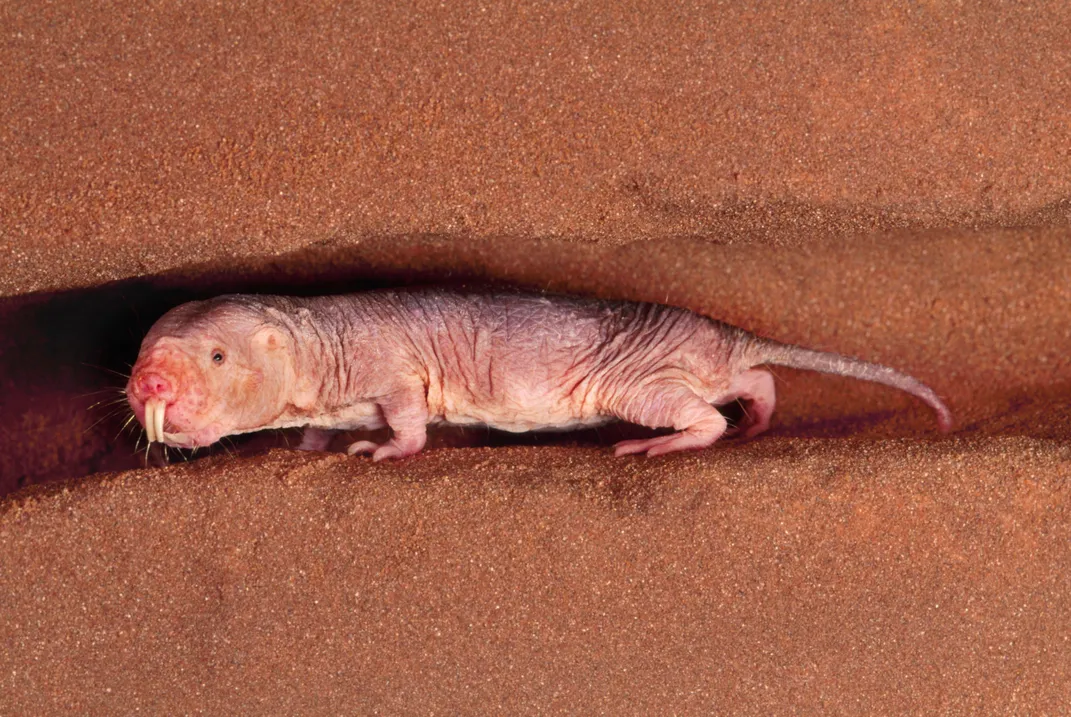The Secret to a Long Life: Be Cooperative and Live Underground
Naked mole rats enjoy exceptionally long, healthy lives, and there’s more than good genes at work
/https://tf-cmsv2-smithsonianmag-media.s3.amazonaws.com/filer/55/08/55087447-e0dd-4dc2-9492-25d3ad336f6f/molerat_2.jpg)
We all want to live long and prosper, and in the animal kingdom, naked mole rats come closest to achieving that goal. The subterranean African rodents are famed for being so visually repulsive that they’re almost cute—shriveled tubes of pink flesh crowned with two massively protruding teeth. But they are also renowned for their longevity in relation to their size. In birds and mammals, bigger animals usually live longer than small ones, with even the longest-lived mice not making it past three years. Bucking this trend, the 3- to 4-inch-long naked mole rat can live up to 30 years, and the animals usually maintain their health until the very end.
The source of naked mole rats’ fountain of youth has been the subject of much scientific investigation. If we can discover their secret, then perhaps we could apply that valuable information to developing drugs or therapies that extend the duration and quality of our own lifespans. A couple years ago, researchers analyzed naked mole rat biology and discovered that the animals have an abundance of specialized proteins in their tissues that help them prevent cancer. Other work found that the rodents resist the ravages of aging because their genes are very careful about how they go about making new proteins.
But how and why did the mole rats evolve these extraordinary traits? Last year, an analysis of the lifespans and characteristics of 1,400 mammal and bird species revealed that those that spend their lives underground—a very good way of avoiding predators—are also the ones that have the longest lifespans.
Now Scott Williams and Milena Shattuck at New York University have identified a new piece of the puzzle. They believe that the naked mole rat’s exceptionally social and cooperative lifestyle contributes to its longevity. Williams and Shattuck present this argument today in Proceedings of the Royal Society B: Biological Sciences.
The naked mole rat’s cooperative social system most closely resembles that of social insects like ants and termites. Multiple generations of naked mole rats spend their lives in intricately connected subterranean tunnels, and specific jobs are broken down among community members. Naked mole rats designate a queen that exclusively spends her time in a special chamber giving birth to more naked mole rats and nursing pups. Only a select few males can breed with her, while non-breeding subjects provider her with both protection and nourishment.

To figure out how these lifestyle choices might influence naked mole rat longevity, Williams and Shattuck compiled data on lifespan, body size and social characteristics of 440 mammals that spend most of their time either under or on the ground. Then they statistically analyzed those data to see how significant a role each factor played in determining longevity.
The results confirmed that body mass is the surest predictor of lifespan, with smaller animals facing shorter lives. As in the previous work, animals that live underground received a longevity bonus. And as the team suspected, those that lived in highly cooperative societies—including the naked mole rats—enjoyed even longer lives. Further supporting this finding, the team discovered that naked mole rats’ closest relatives—which include both loner species and cooperative socialites—follow the same trend, with the recluses living the shortest lives.
Based on these findings, humans have already seized upon one of the naked mole rats’ secrets to long-term success, the team says. People also generally live in multi-generational societies, have reproductive divisions of labor and are wired to help each other out. While we haven't decided to hunker down in subterranean cities, humans have devised all sorts of other defensive strategies to avoid meeting a premature end. In other words, short of figuring out a way to mimic the naked mole rats’ meticulous way of synthesizing proteins, it seems we’re already following the best practice models for staying alive.
/https://tf-cmsv2-smithsonianmag-media.s3.amazonaws.com/accounts/headshot/Rachel-Nuwer-240.jpg)
/https://tf-cmsv2-smithsonianmag-media.s3.amazonaws.com/accounts/headshot/Rachel-Nuwer-240.jpg)